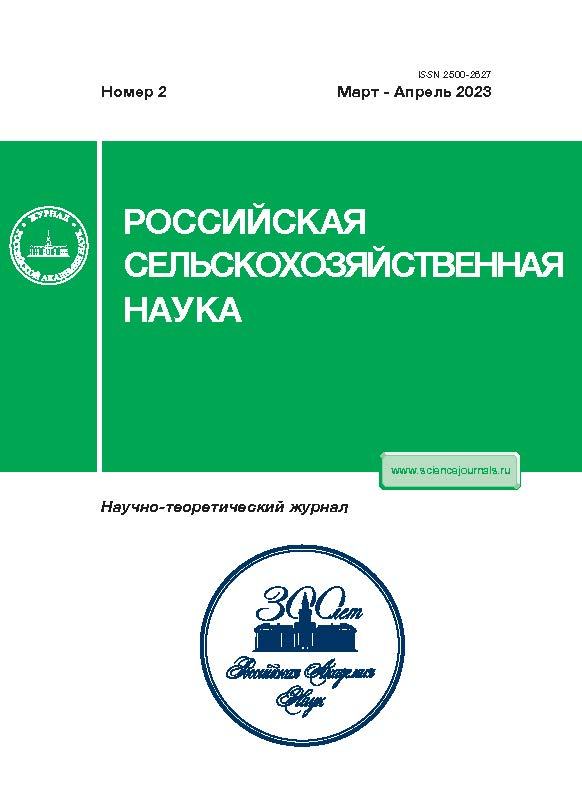Фракционный состав белковых полимеров зерна кукурузы как фактор отбора сортообразцов для повышения питательности кормов
- Авторы: Болотова О.И1, Сазонова И.А1, Бычкова В.В1
-
Учреждения:
- Российский научно-исследовательский и проектно-технологический институт сорго и кукурузы
- Выпуск: № 2 (2023)
- Страницы: 40-44
- Раздел: Статьи
- URL: https://journals.eco-vector.com/2500-2627/article/view/657862
- DOI: https://doi.org/10.31857/S2500262723020096
- EDN: https://elibrary.ru/APWMFN
- ID: 657862
Цитировать
Полный текст
Аннотация
Исследование проводили с целью выявления сортообразцов c высоким содержанием полноценного белка для использования в дальнейшей селекционной работе и кормлении животных. Объектами исследования были сортообразцы кукурузы селекции ФГБНУ РосНИИСК «Россорго»: РНИИСК 1, РСК Заря, Радуга, РСК Аврора, РСК Граскорн, Артемида, РСК 7, РСК 3, РСК 354, Нова, Цукерка, 421/20. Работу выполняли в Саратовской области в 2020-2021 гг. Для анализа использовали зрелое измельченное зерно. Исследования проводили методом экстракции для разделения белков на фракции по схеме Осборна в трехкратной повторности. По количеству водорастворимых белков - альбуминов имели превосходство сортообразцы Артемида (16,98 г/100 г белка), Нова (16,83 г/100 г белка), РСК Граскорн (16,32 г/100 г белка) и Цукерка (15,68 г/100 г белка). Наибольшим содержанием глютелинов среди изучаемых образцов характеризовался сорт Радуга (25,69 г/100 г белка), наименьшим - Цукерка (16,68 г/100 г белка). Наибольше количество проламинов в зерне отмечено у сорта Радуга (23,47 г/100 г белка), за ним следовали линия РСК-7 (22,89 г/100 г белка) и сорт РСК Аврора (22,2 г/100 г белка). Наименьшее содержание нерастворимого белка в остатке зафиксировано в зерне сорта Цукерка (12,45 г/100г белка). Наиболее полноценным белком, который отличался самым высоким содержанием водо- и солерастворимых фракций при одновременно низком количестве нерастворимого белкового остатка характеризовались гибриды Артемида, Нова.
Об авторах
О. И Болотова
Российский научно-исследовательский и проектно-технологический институт сорго и кукурузы
Email: gelechrisum@gmail.com
410050, Саратов, 1-й Институтский проезд, 4
И. А Сазонова
Российский научно-исследовательский и проектно-технологический институт сорго и кукурузы410050, Саратов, 1-й Институтский проезд, 4
В. В Бычкова
Российский научно-исследовательский и проектно-технологический институт сорго и кукурузы410050, Саратов, 1-й Институтский проезд, 4
Список литературы
- Shah T.R., Parsad K., Kumar P. Maize - a potential source of human nutrition and Maize-A potential source of human nutrition and health // Cogent Food Agric. 2016. Vol. 2. URL: https://www.tandfonline.com/doi/full/10.1080/23311932.2016.1166995 (дата обращения: 09.09.2022). doi: 10.1080/23311932.2016.1166995.
- Тупольских, Т. И., Вифлянцева Т. А. Анализ влияния химических способов замачивания зерна кукурузы на растворимость белков // Молодой исследователь Дона. 2018. № 2(11). С. 102-106.
- Тосунов Я.К., Чернышева Н.В., Барчукова А.Я. Влияние обработки семян кукурузы агрохимикатом Вуксал Тернос Универсал на рост, формирование репродуктивных органов и урожайность кукурузы // Плодородие. 2018. №6. С.23-26.
- Продуктивные гибриды кукурузы для успешного агробизнеса // Аграрная наука. 2020. № 9. С. 65.
- Martinez E.L., Fernandez F.J.B. Economics of corn production, marketing and use // Chemistry and technology / ed. S.O. Serna-Saldivar. Amsterdam: Elsevier, 2018. Р. 87-106.
- Экологическое изучение гибридов кукурузы в степной зоне Нижнего Поволжья / С. А. Зайцев, Д. П. Волков, Л. А. Гудова и др. // Аграрный научный журнал. 2022. №4. С.13-17. doi: 10.28983/asj.y2022i4pp13-17.
- Bouis H.E, Saltzman A. Improving nutrition by bioenrichment: A review of Harvest Plus, 2003 through 2016 // Glob Food Security. 2017. Vol. 12. Р. 49-58. URL: https://www.sciencedirect.com/science/article/pii/S2211912417300068?via%3Dihub (дата обращения: 25.10.2022). doi: 10.1016/j.gfs.2017.01.009.
- Айрумян В.Ю., Сокол Н. В., Ольховатов Е. А. Химический состав продуктов переработки зерна риса и кукурузы для повышения пищевой и биологической ценности хлебобулочных изделий // Ползуновский вестник. 2020. № 3. С. 3-10. doi: 10.25712/ASTU.2072-8921.2020.03.001.
- Wu Y., Messing J. Proteome balancing of the maize seed for higher nutritional value // Front. Plant. Sci. 2014. Vol.5. P. 240-252. doi: 10.3389/fpls.2014.00240.
- Ranum P., Pena-Rosas J.P., Garcia-Casal M.N. Global maize production, utilization, and consumption // Ann.N. Y. Acad. Sci. 2014. Vol. 105. P. 1312-1337.
- Evaluation of maize germplasm based on zein polymorphism from the archipelago of Madeira / I.R.A. Freitas, F. Ganança, T. Santos, et al. // Maydica. 2005. Vol. 50. P. 105-112.
- Landry J., Delhaye S., Damerval C. Protein distribution pattern in floury and vitreous endosperm of maize grain // Cereal Chem. 2004. Vol. 81. P. 153-158. doi: 10.1094/ CCHEM.2004.81.2.153.
- Temporal patterns of gene expression in developing maize endosperm identified through transcriptome sequencing / G. Li, D. Wang, R. Yang, et al. // Proceed. Natl. Acad. Sci. U.S.A. 2014. Vol. 111. P. 7582-7587. doi: 10.1073/pnas.1406383111.
- Осборн Т.Б. Растительные белки / Перев. с англ. под редакцией проф. А.Р. Казель. М.; Л.: Биомедгиз. 1935. 220 с.
- Бутовец Е. С., Красковская Н. А., Даниленко И. Н. Многокритериальная оценка гибридов кукурузы в условиях Приморского края // Земледелие. 2020. № 4. С. 26-28. doi: 10.24411/0044-3913-2020-10407.
- Мартынов С.П. Статистический и биометрико-генетический анализ в растениеводстве и селекции. Пакет программ "AGROS 2.09". Тверь. 1999.
- Селекция новых гибридов кукурузы с пониженной уборочной влажностью зерна / А. В. Гульняшкин, Н. А. Лемешев, А. А. Земцев и др. // Труды Кубанского государственного аграрного университета. 2020. № 85. С. 61-67. doi: 10.21515/1999-1703-85-61-67.
Дополнительные файлы









